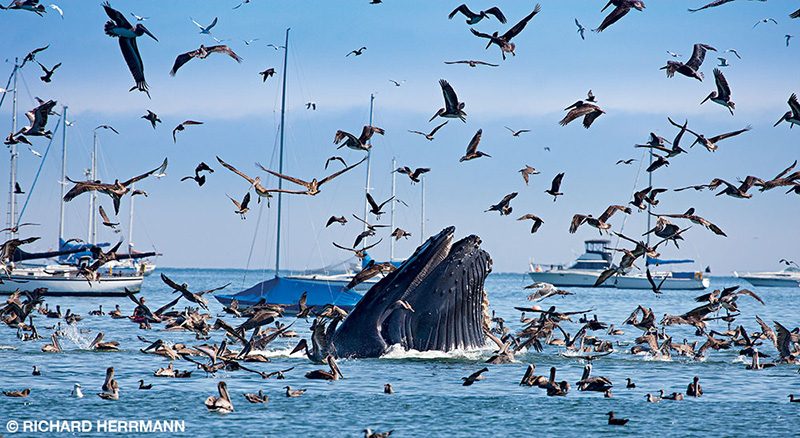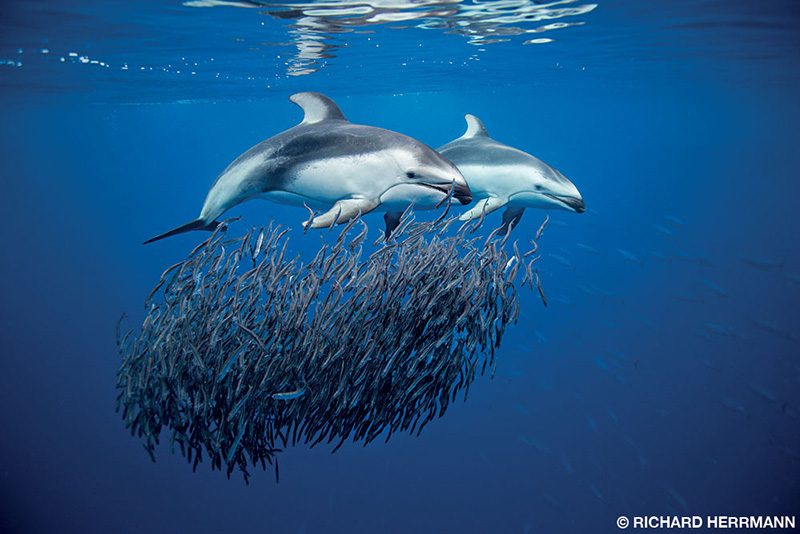When you’re out to sea, you may occasionally observe in the distance a big group of birds circling over one area and then diving and crashing the surface. As you get closer, the birds might swirl like a tornado as the action becomes more frenzied. You may even smell it if you are downwind. The water is agitated and foaming near the edge of the group of birds as they aggressively attack the beleaguered food source right at the surface. These signs mean there may be treasures to find below the birds.
Old salts and fishers often talk about the ability to read the birds. Based on the species of birds, their activity and the geographic zone, you could have an idea of where a feeding event might develop. The species present could also indicate the food source. Small pickers such as petrels and phalaropes feed on krill but would not be the main birds present for baitfish such as anchovies and sardines. Brown pelicans of the eastern Pacific are large birds that make spectacular dives and big splashes when they attack baitfish. Shearwaters, cormorants, boobies and gannets also prefer baitfish and can dive well below the surface. Some species, such as the cormorant, can dive to up to 100 feet. Their diving ability allows these birds to compete with ocean predators for food — images from the South African sardine run show gannets, sharks and dolphins all in the same frame.
Prey such as squid, krill and baitfish attract predators. When a large aggregation of these animals is driven to the surface, the predators gain a huge advantage. Their strategy is to pin the food source at the surface where it cannot escape. Predators attack the prey from underneath to keep it near the surface. Sometimes it’s dolphins or gamefish such as tuna gathering the bait, while waiting at the surface could be sea lions, sharks, whales and almost always the birds.

The food source can also determine which animals join the feast. I have seen squid and juvenile sardines attack krill to force it into tight balls right at the surface. One day off La Jolla, California, we saw a couple of terns making feeding dives at the surface. Drawing closer, we found a group of large Humboldt squid sticking their tentacles completely out of the water. About 30 of the big squid were grouped together, waving their tentacles back and forth. It was like something out of a science fiction film. We didn’t know what we were observing at first, but we eventually saw that the big Humboldts were scooping krill right into their mouths.
The dynamics of predation make bait balls interesting. One of the most classic bait balls filmed was on BBC’s The Hunt. The film begins off the Pacific coast of Baja California with thousands of bonito forcing a giant bait ball of sardines to the surface. Shearwater birds detect the sardines and dive right into them. California sea lions help round up the baitfish. Once some aggressive silky sharks arrive, the action becomes ferocious. Blood and scales in the water quickly reduce the visibility as the sardines are bombarded from every direction. The number of predators attacking forces the bait ball to get tighter, and after a few hours it is reduced to about the size of a Volkswagen Beetle. As the bait ball becomes smaller and tighter, a Bryde’s whale finally punches through and devours the last remaining sardines.
Large baleen whales are sometimes present during these surface feeding frenzies. Fin, humpback, Bryde’s and minke whales will occasionally join the feeding and aggressively attack bait with their mouths wide open. I have seen a Bryde’s whale opportunistically use tuna to round the bait into a tight ball before blowing through the bait and eating the whole thing. Krill is the primary food source for the blue whale. During filming we have floated in krill for hours watching juvenile squid and sardines eat the krill at the surface and eagerly waiting for a blue whale to sweep through for a mouthful.

The mating event of market squid off the California coast and its coastal islands is especially dynamic. The squid gather in the thousands to frantically mate and lay eggs on soft sand or mud bottoms, usually at night and in the early morning hours. During the day they form large schools that a host of animals feed on. Occasionally boat lights and the full moon attract them to the surface to be attacked by California sea lions, pelagic rays, blue sharks and four different species of dolphins. When this happens, the cormorants and gulls are waiting.
The sardine run off the east coast of South Africa usually gets the most notoriety for birds and predators together. This event occurs from May to June and is based on currents and the resulting productivity. Hundreds and sometimes thousands of cape gannets hit the surface at up to 60 mph to assail the massive bait balls of sardines. The gannets are aggressive and swim down to 40 feet to grab sardines among the common dolphins and bronze whaler sharks.
During such feeding frenzies, companies have filmed the action using aerial cameras among the diving gannets. Unfortunately, more than one bird intent on a feeding dive has collided with a drone, sending the drone into the depths. During a 2007 sardine run shoot, a miniature helicopter collided with a gannet, sending a $90,000 70mm custom film camera on a rapid descent into the water. With more divers now bringing drones on exotic trips, it is important to remember that drone use may result in injuries to feeding birds and can be violate the law in some countries.

Dynamic feeding events and bait balls are impossible to predict. A striped marlin feeding situation that may occur off the Baja coast one year may form 300 miles away the next year. Some events, however, are not totally predictable but are likely enough to make ecotours a viable option for divers: The sardine run in South Africa and sailfish feeding on sardines off Isla Mujeras, Mexico, from December through March are good examples. A few trips are organized each year to see striped marlin feeding on sardines in late November through December off the Pacific side of Baja California.
This type of diving is advanced and not without risk. Sometimes the food source will look for any place to hide, including around divers. I have had a few experiences with dolphins, tuna and sea lions eating the bait right on top of me. If a group of predators includes sharks and whales, they may eat right on top of (and through) the divers. Escaping the bait can be difficult in some situations.
Divers tend to be knowledgeable about marine life, but it could be helpful to refer to some good marine birds reference material and learn the different species for the geographic location you are visiting. Learning about marine birds adds to the overall knowledge base for visits to the ocean environment. On some visits, the birds just might mean everything.
© Alert Diver — Q4 Fall 2019